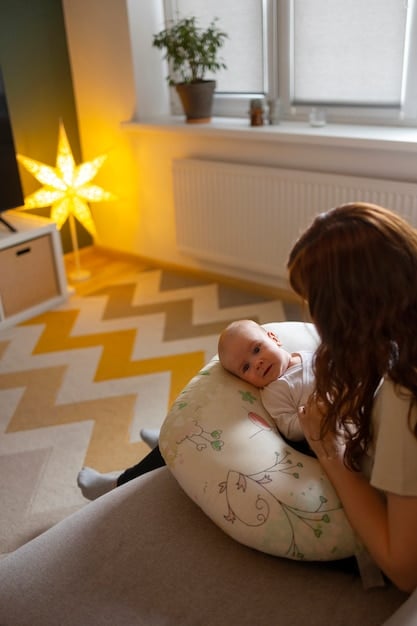Sleep Training SOS: 7 Nights to a Consistent Bedtime Routine

Sleep training doesn’t have to be a nightmare; this guide provides a 7-night plan to establish a consistent bedtime routine, offering exhausted parents proven strategies for helping their little ones drift off to dreamland peacefully.
Is bedtime a battleground? Discover a Sleep Training SOS: Establish a Consistent Bedtime Routine in 7 Nights to transform your evenings from chaotic to calm, ensuring better sleep for your baby and more rest for you.
Sleep Training: Decoding the Mystery
Sleep training, often shrouded in mystery and misconceptions, is simply the process of teaching your baby to fall asleep and stay asleep independently. It’s not about deprivation or distress; it’s about empowering your child with the skills to self-soothe and enjoy restful nights.
Understanding the basics of sleep training can be a game-changer for exhausted parents. Different methods exist, each with its own approach and philosophy. Let’s explore what sleep training really entails.
What is Sleep Training?
At its core, sleep training is about helping your baby develop the ability to fall asleep on their own without relying on external aids like rocking, feeding, or holding. This independence leads to more consistent sleep patterns and better overall rest.
Why Consider Sleep Training?
Sleep deprivation affects not only your baby but also the entire family. Improved sleep can lead to better mood, cognitive development, and physical health for your child. For parents, it means increased energy, reduced stress, and a greater sense of well-being.
- 👶🏻 **Improved Sleep Quality:** Consistent sleep leads to deeper, more restorative rest for your baby.
- 👩👩👧👦 **Happier Family:** When everyone sleeps better, the entire family benefits from improved mood and energy levels.
- 🧠 **Enhanced Development:** Quality sleep is crucial for cognitive and physical development in infants.
- ⏰ **Predictable Routines:** Sleep training helps establish predictable routines, making bedtime less stressful.
Ultimately, sleep training is a tool to help your baby develop healthy sleep habits that will benefit them throughout their life. It’s about creating a peaceful, restorative environment for everyone in the family.
Assessing Readiness: Is Your Baby Ready?
Before diving into sleep training, it’s essential to determine if your baby is developmentally ready. Starting too early or when your baby is going through a growth spurt or developmental leap can lead to frustration and setbacks.
Knowing the right time to start sleep training can significantly influence its success. Consider factors like age, weight, and developmental milestones. Here are some key indicators to watch for.
Age and Weight
Most experts recommend starting sleep training when your baby is between 4 to 6 months old. By this age, babies are typically capable of sleeping through the night without needing frequent feedings. They should also weigh at least 12 pounds.
Developmental Milestones
Ensure your baby is meeting key developmental milestones, such as showing signs of self-soothing, like sucking on their fingers or finding comfort in a favorite blanket. These signs indicate they are ready to learn to fall asleep independently.

- ✅ **Consistent Weight Gain:** Your baby is steadily gaining weight, indicating they are healthy and well-nourished.
- 😴 **Longer Wake Windows:** Your baby can stay awake for longer periods during the day without becoming overly tired.
- 👍🏽 **Self-Soothing:** Your baby exhibits self-soothing behaviors, such as thumb-sucking or finding comfort in a toy.
- 🩺 **Pediatrician Approval:** Always consult with your pediatrician before starting any sleep training method.
Timing is everything when it comes to sleep training. By carefully assessing your baby’s readiness, you can set them up for success and avoid unnecessary stress.
Crafting the Perfect Bedtime Routine
A consistent bedtime routine is the cornerstone of successful sleep training. It signals to your baby that it’s time to wind down and prepare for sleep. This routine should be calming, predictable, and enjoyable for both you and your baby.
Creating a soothing bedtime routine sets the stage for restful nights. The routine should be consistent and followed in the same order each night. Here are some essential components to include.
Bath Time
A warm bath can be incredibly relaxing for babies. The gentle warmth of the water can help soothe muscles and calm their senses. Use a mild, baby-friendly soap to avoid irritating their skin.
Story Time
Reading a story is a wonderful way to bond with your baby and create a sense of calm. Choose books with soothing rhythms and gentle themes. Keep the lights dim and your voice soft and soothing.
Feeding
Offer your baby a feeding before bed, but avoid nursing or bottle-feeding them to sleep. You want them to associate the crib with sleep, not with feeding. A full tummy can help them sleep more comfortably through the night.
- 🛁 **Warm Bath:** A relaxing bath helps soothe your baby before bedtime.
- 📖 **Gentle Stories:** Reading a calming story promotes relaxation and bonding.
- 🧸 **Comfort Objects:** Introduce a comfort object, like a small blanket or stuffed animal.
- 😴 **Consistent Timing:** Sticking to a consistent bedtime helps regulate your baby’s internal clock.
A well-crafted bedtime routine can significantly improve your baby’s sleep patterns. Consistency is key, so try to follow the routine as closely as possible each night, even when traveling or during busy periods.

Choosing Your Sleep Training Method
Several sleep training methods exist, each with its own approach and philosophy. Understanding the different options can help you choose the method that best suits your parenting style and your baby’s temperament. Some popular methods include the Ferber method, the cry-it-out method, and the gentle approach.
Selecting the right sleep training method is a personal decision. Consider your comfort level and your baby’s personality when making your choice. Here’s a closer look at some common methods.
The Ferber Method
The Ferber method, also known as graduated extinction, involves checking on your baby at increasing intervals after putting them down to sleep. This allows them to self-soothe while still providing reassurance.
The Cry-It-Out Method
The cry-it-out method, also known as extinction, involves putting your baby down to sleep and not returning until morning. This method can be effective but is often controversial due to the potential for distress.
The Gentle Approach
The gentle approach involves staying in the room with your baby until they fall asleep, gradually reducing your presence over time. This method is slower but can be less stressful for both you and your baby.
- ⏰ **Graduated Extinction (Ferber):** Checking on your baby at increasing intervals.
- ❌ **Extinction (Cry-It-Out):** Allowing your baby to cry without intervention.
- 🤗 **Gentle Methods:** Staying with your baby until they fall asleep, gradually reducing support.
- 🤝 **Co-Sleeping:** Sharing a bed with your baby (use caution and follow safety guidelines).
Ultimately, the best sleep training method is the one that you feel most comfortable with and that works best for your family. Research each method thoroughly and consider consulting with a sleep consultant for personalized guidance.
The 7-Night Plan: A Step-by-Step Guide
Implementing a 7-night sleep training plan can provide structure and consistency during the process. Each night should build upon the previous one, gradually helping your baby learn to fall asleep independently. This plan is designed to be adaptable to your chosen sleep training method.
Consistency is key when following a sleep training plan. This 7-night guide provides a structured approach to help your baby develop healthy sleep habits. Each night builds on the previous one, reinforcing the routine.
Night 1: Establishing the Routine
Follow your bedtime routine consistently and put your baby down to sleep in their crib. If using the Ferber method, begin with short check-in intervals. If using the cry-it-out method, put them down and leave the room.
Night 2: Increasing Intervals
For the Ferber method, gradually increase the intervals between check-ins. For gentle methods, continue to reduce your presence in the room. Be patient and consistent with your approach.
Night 3-7: Reinforcing the Routine
Continue to follow your chosen method consistently, gradually increasing the intervals between check-ins or reducing your presence in the room. Monitor your baby’s progress and adjust the plan as needed.
- 🌙 **Night 1:** Establish the bedtime routine and put your baby down awake.
- ⏰ **Night 2-3:** Increase check-in intervals for Ferber method or continue gradual reduction for gentle methods.
- 😴 **Night 4-7:** Reinforce the routine and monitor progress, adjusting as needed.
- 📈 **Track Progress:** Keep a sleep log to track your baby’s progress and identify any patterns.
Remember that every baby is different, and some may adjust to sleep training faster than others. Stay consistent and patient, and celebrate even small victories along the way.
Troubleshooting Common Sleep Challenges
Even with the best-laid plans, sleep training can present challenges. Understanding common issues and how to address them can help you stay on track and achieve your goals. Common challenges include resistance to the routine, nighttime wakings, and regressions.
Sleep training isn’t always smooth sailing. Here’s how to handle common obstacles and stay on course toward better sleep for your baby. Anticipate challenges and prepare strategies to overcome them.
Resistance to the Routine
If your baby resists the bedtime routine, try to make it more enjoyable and relaxing. Incorporate elements they love, like a favorite song or a gentle massage. Stay consistent and patient, and they will eventually adjust.
Nighttime Wakings
Nighttime wakings are common, especially in the early stages of sleep training. If your baby wakes up, wait a few minutes before intervening to see if they can self-soothe back to sleep. If they continue to cry, follow your chosen sleep training method.
- 💪 **Stay Consistent:** Sticking to the routine even during challenging times.
- ✅ **Address Comfort Needs:** Ensure your baby is comfortable (not too hot or cold).
- 🩺 **Rule Out Medical Issues:** Consult with your pediatrician to rule out any underlying health concerns.
- 🤗 **Offer Reassurance:** Provide gentle reassurance without picking up your baby unless necessary.
Don’t get discouraged by setbacks. Sleep training is a process, and it takes time and patience. Celebrate small victories and remember that better sleep is within reach.
| Key Point | Brief Description |
|---|---|
| 👶🏻 Readiness Assessment | Ensure baby is 4-6 months old, gaining weight, and showing self-soothing signs. |
| 🌙 Bedtime Routine | Create a consistent routine with bath, story, and feeding, always in the same order. |
| 🛏️ Sleep Training Method | Choose Ferber, cry-it-out, or a gentle approach based on comfort level and baby’s temperament. |
| 📈 Consistency | Stick to the plan, even during challenges, for the best results. |
Frequently Asked Questions
▼
The ideal time to start sleep training is when your baby is between 4 to 6 months old, weighs at least 12 pounds, and shows signs of self-soothing behaviors. Always consult with your pediatrician.
▼
Most babies respond to sleep training within a week or two. Consistency is key, and it may take longer for some babies to adjust. Be patient and continue following your chosen method.
▼
If your baby gets sick, it’s best to pause sleep training and focus on providing comfort and care. Once they are feeling better, you can resume the sleep training process.
▼
Yes, it is okay to sleep train while breastfeeding. Ensure your baby is getting enough calories during the day and avoid nursing to sleep. This helps them associate the crib with sleep, not feeding.
▼
If sleep training isn’t working, consider consulting with a sleep consultant or your pediatrician. They can provide personalized guidance and help identify any underlying issues that may be affecting your baby’s sleep.
Conclusion
Establishing a consistent bedtime routine through sleep training can transform your family’s life, leading to more restful nights and happier days. Remember, consistency, patience, and a tailored approach are key to success in this rewarding journey.





